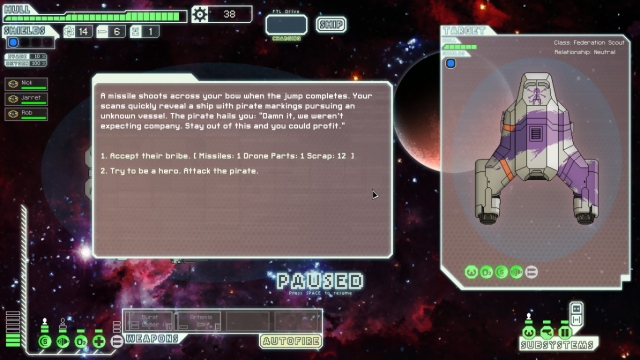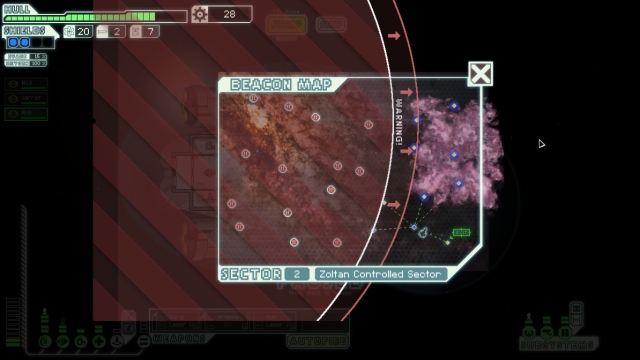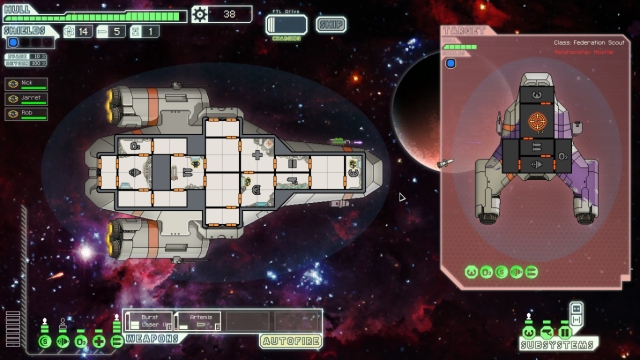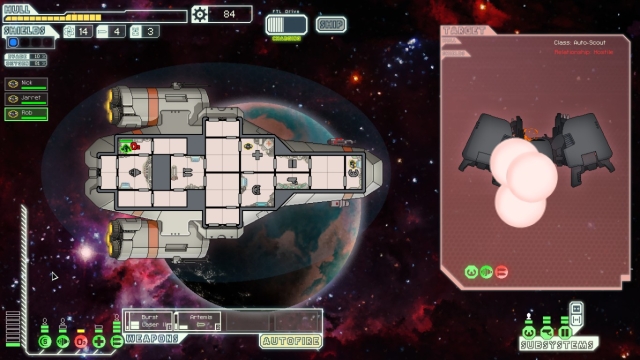When the first Mass Effect was released, there was a commercial that had Shepard receiving a distress call from a nearby outpost. He brusquely shuts off the radio, deciding that their current mission was too important for the distraction. While Mass Effect had Shepard make some challenging decisions, that moment never occurred, and Mass Effect was not quite the game advertised in that commercial.
FTL: Faster Than Light is that game.
FTL is best described as a rogue-like space sim. What this means is that you control a ship and crew as it navigates a randomly generated universe. Your ship is a member of the recently defeated Federation, and you are tasked with ferrying an important message to the Federation Homebase eight sectors away. Hot on your pursuit is the evil Rebellion. If you take too long making your way to the sector exit, the Rebellion will progressively encroach upon the map, from left to right, forcing you to the exit. Getting caught in a rebel controlled sector guarantees a battle against a powerful ship. You won’t have to beat it, but you will need to jump away out from the Rebel Domination.
Combat is whatever you want it to be in FTL. The game allows you to play however you want. You are given the choice of outfitting your ship with various weapons, drones, and equipment to suit your play-style. Weapons, from various missile launchers to ion cannons and beams, allow you to directly assault the enemy ship. Drones can be purchased that will automatically attack, defend, or even repair your own system as needed. If you like hand-to-hand combat, you can purchase a teleporter that will allow your crew members to battle onboard in the opposing ship. Each component of the ship can be upgraded, so the more aggressive captains can build up their artillery, while the defensive-minded pilots can fortify their shields. As your ship is assaulted, systems take damage, and the crew will need to risk their necks to get enough systems back online to either defeat their assailants, or power up the FTL drive and fly to another beacon, praying that they will not be greeted with hostility.

The currency of the game is scrap. As you defeat ships, you will collect scrap (along with fuel, missiles, and drones). Scrap can be used at vendors to repair your ship, purchase new equipment, or hire crew. It can also be used to upgrade your ship’s systems. This is where the challenge of the game becomes apparent: you need to travel to as many new beacons as possible to find as much scrap as you can, but you’ve got to do so before the Rebellion pushes you out of the sector. You need to power your ship up as much as you can, because if you make it all the way to sector 8, you’re rewarded with a fight against the Rebel Flagship, which is equipped with every upgrade possible. Any outcome other than defeating the flagship is a loss.
The universe consists of various environments, ranging from friendly to hostile. Friendly doesn’t always mean there won’t be trouble. Nebulae will impact your sensors, leaving you blind to parts of your ship that aren’t manned. Some beacons are in asteroid fields, and without effective shields you won’t last long. Others are near stars, which unleash solar flares that damage anything in the proximity. Battles in the hostile environments can be tense, because while you might be able to outlast the other ship, you still need to make sure your engine has enough time to power up.

There are six races of aliens available. Only the human ship, the Kestrel, is unlocked at the start, but as you progress through the game, either through quests or achievements, other ships will be unlocked. Each alien race has different strengths and weaknesses that you will want to leverage when assigning roles onboard the ship. For example, the Engi are a technological race that have reduced combat ability, but double the repair ability, making them ideal for manning stations and performing repairs. Rockmen have enhanced health, making them great for defending against intruders. As games are apt to do, humans are the default and thus, have no strengths or weaknesses.
The graphics suit the game perfectly. Crew members are represented by sprites that travel around your ship, engaging in different actions such as repairing systems, putting out fires, or manning stations. The ship itself will reflect various upgrades. Weapons emerge from the hull when powered up, and as they charge, little lights on the weapons themselves indicate just how close they are to firing. Backgrounds are dynamic, especially in asteroid fields, which helps indicate the danger of the zone. The sound also works, with assorted beeps and blasts, to indicate when you are taking damage and when something is happening that requires immediate attention. During combat, there can be many things happening at once, and the graphics and sound work together to emphasize the chaos of battle and provide a sense of immersion. Probably the weakest part of the game is the ‘futuristic’ music. It does add to the atmosphere, but it’s nothing beyond simple background music.
The only real complaint I have is that of the several ship types available, only one is available at launch. The Kestrel is a great beginners ship – it even emphasizes the strategy of having to balance your weapons against your engines by not providing enough power to fully support all systems at once. But after a few play-throughs, it’s a bit frustrating to know there are all these other ships mentioned in the Hangar that you can’t access yet. I’m not advocating that all ships should have been unlocked at start, but at least one or two more to allow for some more freedom at the outset.

Of the few ships I’ve unlocked, my favorite has been the Engi Vortex, with the lone Engi piloting and commanding a number of drones as his support. After picking up a couple of crew members of various alien races, my Engi was busy repairing the shields when a direct blast killed him. The remaining crew members were able to keep the ship functioning during the rest of the battle, and continued on into space, but it felt bittersweet knowing that the one being that had started this mission would not be there to see it to its completion.
As you are outrunning the Rebellion, you will see beacons marked “Distress.” You will look at the map, with your mixed crew of humans and aliens behind you (in spirit) as you determine whether you can afford to stop at the beacon. You will decide that it’s not worth the risk, and you will fly on to your next destination. The characters in FTL may lack personality or character, unlike an RPG, but you will become attached to them, and you will be disappointed when your ship meets its demise. Many decisions lie ahead, none of them easy, except for the decision of whether or not you should get FTL: Faster Than Light. You totally should.





